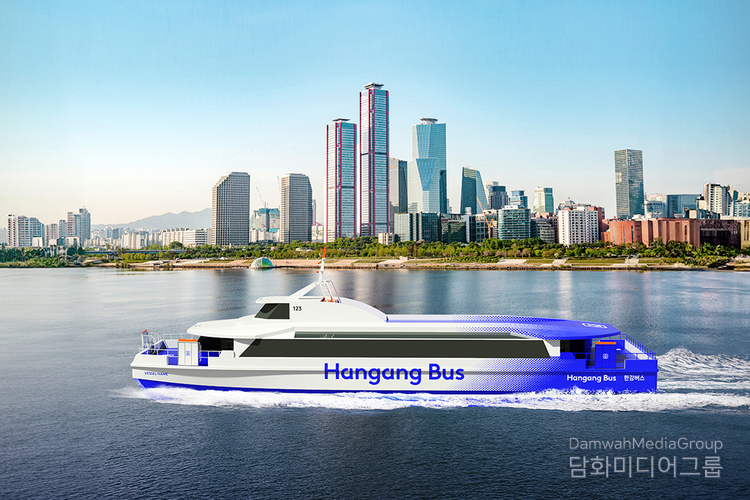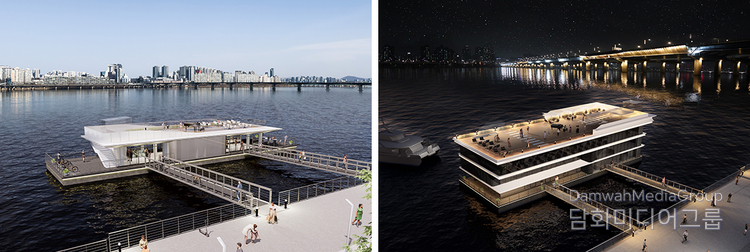By UN Journal Lee Kap-soo
Seoul Metropolitan Government will launch the Hangang Bus, a new waterborne means of transportation, with two newly constructed catamarans ready for service, this year.
These vessels’ specially designed low-profile hulls will minimize wave impact and allow them to pass under Jamsugyo, the city bridge with the lowest boat clearance, that sits right below Banpodaegyo Bridge.

Their white base color with a gradient of blue hues echoes the river’s shifting appearance throughout the day, creating a visual connection between the vessels and the natural surroundings.
Eunsung Heavy Industries constructed the first two vessels in the Hangang Bus fleet. Both are currently undergoing maritime trials and safety inspections in coastal waters under the supervision of the Korea Maritime Transportation Safety Authority. After their scheduled delivery in December, the Hangang-based operational fleet will be expanded gradually through the construction and delivery of six additional vessels, with four more to be held in reserve.
The service will connect four strategic locations along the river – Magok, Yeouido, Oksu and Jamsil – when launched in March, with stops at Mangwon, Jamwon and Ttukseom added by November, according to the Seoul Metropolitan Government.
Each vessel can transport up to 199 passengers and crew and will be available to commuters and tourists alike. The planned hours of operation are 6:30 a.m. to 10:30 p.m. on weekdays and 9:30 a.m. to 10:30 p.m. on weekends. The “going up” service will start in Magok and terminate in Jamsil, with the “going-down” service operating in reverse. Regular departures are scheduled to take place every 30 minutes.

The riverine buses are set to run every 15 minutes during weekday rush hour traffic (6:30 to 9:00 a.m. and 6:00 to 8:00 p.m.). The initiative aims to reduce traffic congestion while enhancing the city’s tourism appeal and modernizing its public transportation system. The carefully selected stops provide access to key business districts, residential areas and recreational spaces, maximizing the service’s utility.
The Hangang Bus offers passengers an engaging travel experience complete with modern amenities and facilities. The vessels’ interior layout prioritizes comfort while maximizing viewing opportunities. The large windows and well-planned seating allow passengers to fully appreciate the riverside scenery that ranges from Yeouido’s towering financial district to Ttukseom’s parklands. The service demonstrates Seoul’s commitment to sustainable urban development, potentially serving as a model for other cities worldwide seeking innovative solutions to transportation challenges.
The Hangang Bus will undergo extensive testing to ensure smooth vessel operations and dock management and be put into service only after passenger comfort and safety can be guaranteed. These trials will focus on verifying service quality and identifying any operational issues that need to be addressed.
A full-length trip from Magok to Jamsil will take about 75 minutes. During rush hours, express service with only one stop at Yeouido will cut about 20 minutes off of that time. Each trip is expected to be 3,000 won, and the Seoul Metropolitan Government is in talks to arrange discount passes for regular bus and subway commuters and to make the service available to all Climate Card holders as well.
The Hangang Bus project represents a harmonious blend of practical transportation solutions with aesthetic and environmental considerations, promising to become an integral part of Seoul’s urban infrastructure while offering residents and visitors an innovative way to experience the city.
This waterborne transportation system not only addresses current urban mobility needs but also positions Seoul at the forefront of sustainable transportation innovation, creating a blueprint for other metropolitan areas facing similar urban development challenges.






